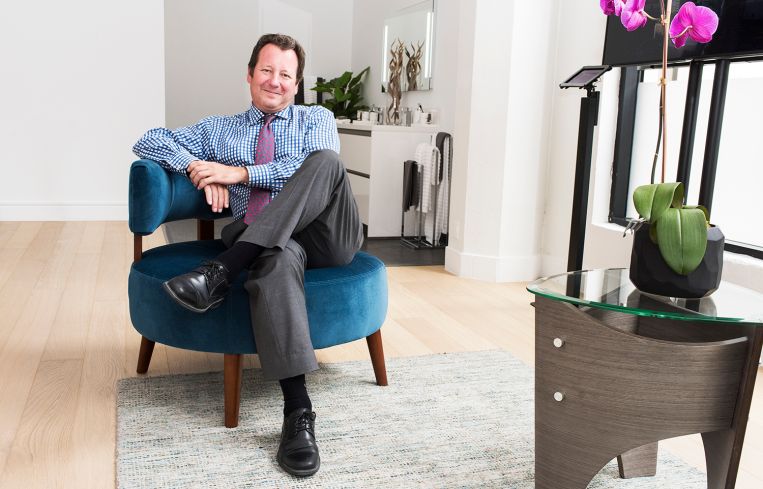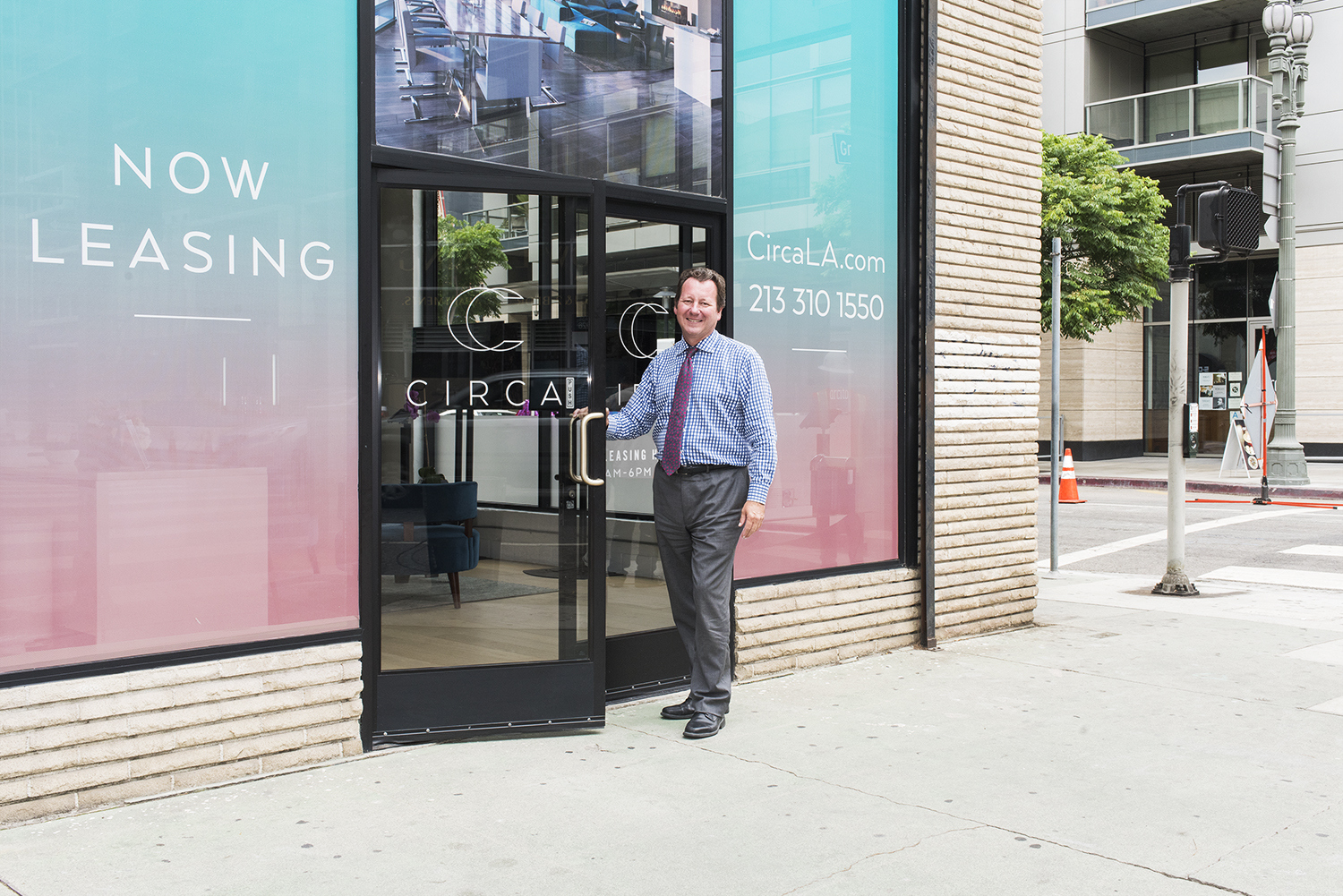Scott Dobbins of Hankey Investment Talks Circa and the Evolution of DTLA
By Alison Stateman August 6, 2018 11:14 am
reprints
For those observing the ongoing high-rise buildings emerging throughout Downtown Los Angeles, it’s hard to imagine what it was like just 20 years ago. Scott Dobbins, the president of Hankey Investment Company, has watched Downtown L.A. transform from an area that was deserted after the workday ended to a bustling metropolis set to become a higher density 24/7 hive of activity.
The 53-year-old Seattle native, who lives in Manhattan Beach with his wife and three children ages 16, 14 and 12, is betting that Circa, the massive $500 million dual-towered luxury development at 1200 Figueroa Street that he lead the development team on will further the urban transformation. The luxury South Park development located across the street from LA Live and the Staples Center, which when it opened in 1999 was the first step toward giving people a reason to be Downtown after the workday ended, is set to open this September.
The project features 648 market-rate apartments and 48,000 square feet of retail and restaurants within the two, 35-story glass towers, with the smallest measuring around 700 square feet, and the largest penthouses measuring around 4,000 square feet. Rents are expected to range from $3,000 to $25,000 a month. Dobbins spoke to Commercial Observer recently at the Circa leasing office at 1200 South Figueroa Street about the state of leasing at the project, which is being handled by Greystar, what’s cooking with development Downtown overall and his own career trajectory, starting in the depths of Black Monday in 1987 back to his 20-plus years at Hankey.
Commercial Observer: How did you get into real estate?
Scott Dobbins: I put myself through school working for Boeing in roofing and construction over the summer. I was hands-on. I had experience in blue-collar construction and went from there to wearing a suit and a tie in New York City. So, I got both ends of the scale and hopefully understand how different people work in different situations.
What led you to New York?
I studied undergrad finance and the University of Washington so I intended to go to New York City. In 1987, [on] Black Monday, I woke up and the stock market crashed and I thought, you know what? It’s not going to hurt to go to New York City and try. And so, I did. They were still laying off but I got hired at the derivatives group at Merrill Lynch, which was still kind of a new venture for the banks at the time. I spent four-plus years there and decided to go back to grad school. I wanted to get my MBA and wanted to head back to the West Coast and figured San Francisco or L.A. were probably the places to land.
What made you want to move from finance to real estate?
It’s one of the avenues where you can make money yourself. It’s an entrepreneurial start to making money. I stepped from finance to MBA where I majored in finance in real estate [at USC Marshall School of Business] and then I started working for Colony Capital.
That was back in the 1992, 1994 recession in real estate, so it helped to buy notes. My finance [background] helped me value housing stock and see assets so that was a good segue. Then I started working for my boss, Don Hankey, [at Hankey] 20 years ago now and he’s now a billionaire, which is one of the reasons we’ve been able to take on a project like this. He wasn’t a billionaire when I first started working for him.
You run his real estate company, but haven’t you had several roles since you joined Hankey?
We never did development so when I started we had some investments in real estate. You manage those investments. You try to make the most out of those. Then I went into real estate lending, another one of my business lines is bridge lending. We have about $850 million now in bridge loans. That didn’t necessarily drive development, but Circa came through the door from a potential loan property. That’s how I got interested in this land. I guess you could say lending turned into development. That was about 2012.
That was Circa. Tell us how it came together.
One of our partners, Shawn Zachary put the land in escrow and came to us for a loan in 2012 but saw we had the bandwidth to do more than just lending and asked us to be an equity partner. We said, “no, we want to stick with our lending business,” but, over time, we saw his vision for the property and eventually ended up being partners. [Hankey is the majority owner of Circa.]
Let me give you a little history of the land. Back when the Staples Center was being built in 1998 the CRA [Community Redevelopment Agency] came in and helped eminent domain take the land around the Staples Center for future development, including the piece we had and then they gave those to AEG and AEG entitled them to the LA Sports and Entertainment District specifically. Our Circa is part of that specific plan and it details how many apartments and how many condos you can put on it and how much square footage of retail. The LED signage is all a part of that. It’s a plan that’s 15 years old by now.
AEG had a big hand obviously with the Staples Center, but they had a big hand in the form of the whole neighborhood. They turned around and sold that land to a developer in the last cycle, the South Park Group, the same people behind Illumina and 11 and Evo, who lost it. The bank took it back and then a parking company bought it from a bank and my partner Shawn knew someone at the parking company and said, “hey you’re not going to want to develop it, why not let me develop it?”

What was his vision?
A lot [of what could be done]was in place because of AEG. We knew what we could do, we just had to put the building blocks together and build it.
We ended up with curving circular towers, round pools—two pools where maybe you would have only had one. [There were] a lot of decisions along the way to form Circa. We’re trying to create a lifestyle at Circa. We are the highest-end product for leasing in Downtown. We built them to condo specs. We could sell them as condos. You have two Chinese projects and a Korean project but we’re the largest local developer Downtown and our intent rather than sell them off as condos is to keep [the building]. We want Circa to be special because we’ll be involved with Circa for decades to come.
Aren’t you also working with Jamison Properties?
Yes. Shawn brought the initial property to the table and he was really the vision for the project. And we brought in Dr. David Lee [of Jamison]. He’s a very smart man and my development team is really his group, so between his brains and his development team, we’ve been able to get the project to where it is today. And then [with] my boss who has the financial wherewithal, we’ve been the anchor to fund it.
How do you define what you call the “Circa lifestyle”?
It’s work and play. I think a lot of these people, they’ll work [either at offices] Downtown and there are a fair number of people who work out of their home Downtown. We have two dog parks. I think 60 percent of the people Downtown have dogs. We have a freestanding gym, we have a 75-foot lap pool, 13 Viking barbeque stations.
Some of the other big developments Downtown are condos and that’s what sets us apart. We’re going to be leased apartments so people that don’t want to buy are going to be able to lease from us and we’ll be at the high-end of the market, admittedly. Circa is going to be lifestyle. Yes, it will be a higher-end lifestyle, but I think we’ve provided for that and projects like ours help bring excitement into Downtown L.A. as it evolves more into that 24/7 lifestyle. Circa is at the forefront of that.
Who is your audience?
People who already live Downtown. Some work out of their homes, some are going to work Downtown. There’s quite a few international people who come through our towers as well.
Are they from any specific countries?
More Asian than not, but there are a lot of transplants that come here from Boston and New York and San Francisco as well.
Why do you think that is?
They’re more used to an urban living and they’re comfortable with it. That’s one of the things that’s changed in Downtown L.A. Twenty-five years ago when I worked in Downtown L.A. it was a ghost town at 6 o’clock. It was a ghost town on the weekends and now you have neighborhoods that are coming up. You have South Park, the Arts District, Spring Street. There are families down there now and I think it’s going to be more of that 24/7 lifestyle that other cities have.
You also have 48,000 square feet of retail space in the building. What’s the status on that?
That’s a hard one, I don’t want to say until I have a lease in hand. We’ll probably have two large restaurants—about half the retail can be restaurants. So, with L.A. Live and the Staples Center and Convention Center across the street, you’ll get daytime and evening use so there is a definite demand there for that and then those restaurants can service the people who are at Circa.
Any grocery tenants coming to Circa?
We have people who want in, but I actually haven’t pulled the trigger on that one yet.
What about the state of residential leasing so far for Circa?
We’ve only been open about two weeks, but we’re signing leases daily and it’s been great. I have six units at about $25,000 a month and I already have four of them leased—four of the six of the biggest penthouses. Our penthouses range from $10,000 to $25,000. We have 36 penthouses, but the largest ones are six at 4,000 square feet.
Are those international or local people who are leasing those?
They’re all local.
What’s the demographic?
I don’t want to speak to that, but they are local successful people. Some are moving from other towers and some are Californians getting another residence in Downtown Los Angeles. I think some of what you’ll see is they will treat it like the New York pied-a-terre. You’ll have Downtown residents as well. It’s funny. A lot of people in Beverly Hills have a Malibu House and now they’ll have a Downtown house. I’m sure there will be more of that.
You have a lot of competition Downtown for residents, no?
Yeah, Mack Urban [is building] a great apartment [building], but they’re going to be smaller, less expensive units.
You’re also working on a number of other projects.
We’re partners with City View, and a project called Pearl on Wilshire. We just opened and move-in was last week so that’s a great start. Leasing is going great over there. I’m doing more creative office and then following up on the success of Circa, we brought Jamison in for a 644-unit high-rise on the edge of Koreatown, right there on Wilshire. That project is supposed to get started in September when we’re taking move-ins for Circa so we’ll continue with our same team over there.
How do you respond to critics that say that much of the development happening Downtown looks very cookie-cutter?
I would hope that people would think ours are creative to begin with. The circular towers, the circular pools. No city can control what it looks like. I’m just excited for the density that is coming Downtown. It’s great. We’re proud that Circa is part of that and it is different.
What do you think of the linkage fee that the city passed for commercial development to go toward affordable housing?
I’m a developer and I know it’s done in other cities, but I know they’ve also taxed people locally for it. [In 2016, L.A. voters approved Proposition HHH Permanent Supportive Housing Loan Program, which aimed to build 10,000 units of housing, financed by a $0.348 per square foot property tax to fund the $1.2 billion measure.]
Are you planning on getting a place yourself Downtown?
No. I’m sure there will be a unit I’ll be spending time in, but I’m not going to take one full-time with my family.
You mentioned that your product is very high-end. People say that there is a lack of affordable housing in California and Los Angeles in particular. Is there anything your company is doing to address that?
I am building other projects that have an affordable component that we have to sell for a tenth of the price of what the market would be so they live in the same buildings, in the same apartments [as market-rate residents]. I’m doing some in Koreatown. I’m doing some in the Valley. I just did one in Van Nuys. They are just leased for much less.


